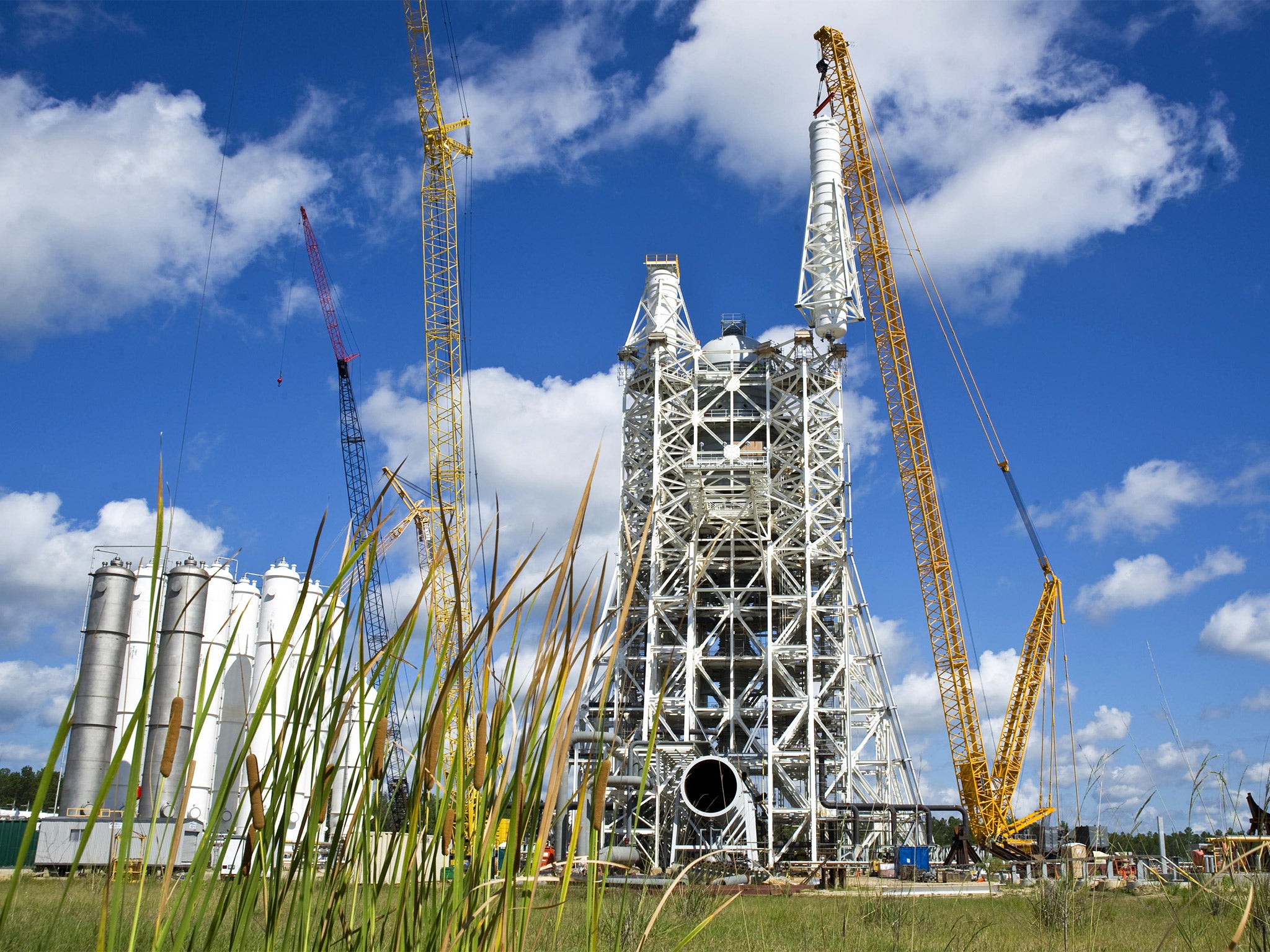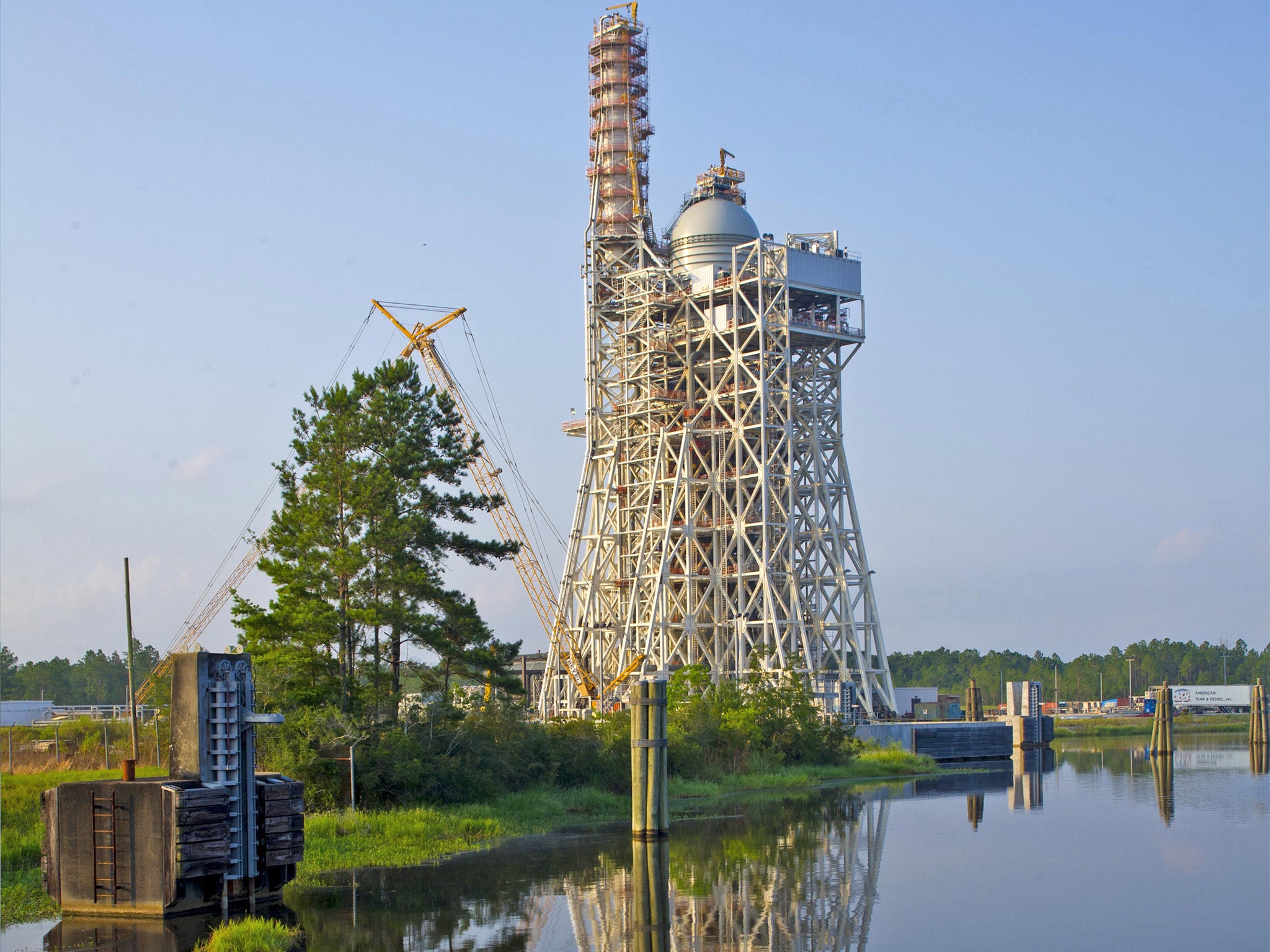The $349m rocket mission that failed to take off
Nasa's mothballed tower is a costly symbol of failure

Your support helps us to tell the story
From reproductive rights to climate change to Big Tech, The Independent is on the ground when the story is developing. Whether it's investigating the financials of Elon Musk's pro-Trump PAC or producing our latest documentary, 'The A Word', which shines a light on the American women fighting for reproductive rights, we know how important it is to parse out the facts from the messaging.
At such a critical moment in US history, we need reporters on the ground. Your donation allows us to keep sending journalists to speak to both sides of the story.
The Independent is trusted by Americans across the entire political spectrum. And unlike many other quality news outlets, we choose not to lock Americans out of our reporting and analysis with paywalls. We believe quality journalism should be available to everyone, paid for by those who can afford it.
Your support makes all the difference.Nasa finished work on a huge construction project in Mississippi in June. It was a $349m (£223m) laboratory tower designed to test a new rocket engine in a chamber that mimicked the vacuum of space.
Then the agency did something odd. As soon as the tower was built, it was shut down.
The project was mothballed without ever being used. “You lock the door, so nobody gets in and hurt,” said Daniel Dumbacher, a former Nasa official who oversaw the project.
The reason for the shutdown: the new tower – called the A-3 test stand – was useless. Just as expected. The rocket programme it was designed for had been cancelled in 2010.
But, at first, cautious Nasa bureaucrats did not want to stop the construction. And then Congress – at the urging of a senator from Mississippi – swooped in and ordered the agency to finish the tower, no matter what. The result was Nasa spent four more years building something it did not need. Now, the agency will spend about $700,000 a year to maintain it in disuse.
The empty tower is evidence of a breakdown at Nasa, which used to be a glorious symbol of what an American bureaucracy could achieve. In the Space Race days of the 1960s, the agency was given a clear, galvanising mission: reach the Moon within the decade. In less than seven years, Nasa got it done.
Now, Nasa has become a symbol of something else: what happens to a big bureaucracy after its sense of mission starts to fade.
In the past few years, presidents have repeatedly rewritten Nasa’s goals. The Moon was in. The Moon was out. Mars was in. Now, Mars looks like a stretch. Today, the first goal is to visit an asteroid.
Nasa lost its sense that any mission was truly urgent. Officials let projects run over time and budget. In Mississippi, Nasa built a monument to its own institutional drift. The useless tower was repeatedly approved by people who, in essence, argued that the American space programme had nothing better to do.

“What the hell are they doing? I mean, that’s a lot of people’s hard-earned money,” said David Forshee, who spent 18 months as the general foreman for the pipe fitters who helped build the tower. Like other workmen, he had taken pride in this massive, complicated project – only to learn that it was in mothballs. “It’s heartbreaking to know that, you know, you thought you’d done something good,” he said. “And all you’ve done is go around in a damn circle, like a dog chasing his tail.”
Seven years ago, when the tower still seemed like a useful idea, the governor came to the groundbreaking. So did a congressman. Two senators. In August 2007, next to a canal full of alligators, somebody laid down AstroTurf and dirt over the sandy Mississippi soil. The dignitaries stood on the fake grass. They stuck gold-painted shovels into the fake earth. They said they were starting one of the greatest journeys in human history: Nasa would test the rockets that would take Americans back to the Moon. And then even farther, on to Mars.
“You who live in Mississippi and who work at this space centre will see that frontier opening,” said Shana Dale, who was then Nasa’s second-in-command. “You’ll hear it, too: the rumble of Moon-bound rockets being tested here. The thunder of possibility; the roar of freedom.”
The tower was intended to test a rocket engine called the J-2X. The plan was for a spacecraft to carry it up out of the Earth’s atmosphere. Then the engine would ignite and propel the spacecraft toward the Moon. At the very beginning, Nasa projected that the tower would cost $119m. It was supposed to be finished by late 2010. The estimated cost increased to $163m. To $185m. Then beyond that.
At Nasa, as at other large government agencies, this was an old institutional vice: making a big purchase, then letting the cost get bigger and bigger. In the final years of the project, word began to filter out on the site. What they were working on might not be needed after all.
Work on the tower ended last summer. Last year, the agency’s inspector general found six other test stands that were either in “mothball” status, or about to be. Some had not been used since the 1990s. Together, they cost Nasa more than $100,000 a year to maintain.
Nasa would not allow a reporter to visit the disused tower up close. The only way to see it was to pay $10 at the visitor centre and take the official Stennis Space Centre bus tour. The guide drove past several test stands left over from the glory days of the 1960s, and recounted how exhausts billowed, and the earth shook.
The bus drove by the B-2 stand, now under construction. Then the bus passed a skeletal, white-painted tower, alone in the distance. “The one to the left there is called the A-3,” the guide said. So what does that one do? “It actually does not have a customer,” the guide said. “So it’s just kind of hanging out.”
© Washington Post
Join our commenting forum
Join thought-provoking conversations, follow other Independent readers and see their replies
Comments